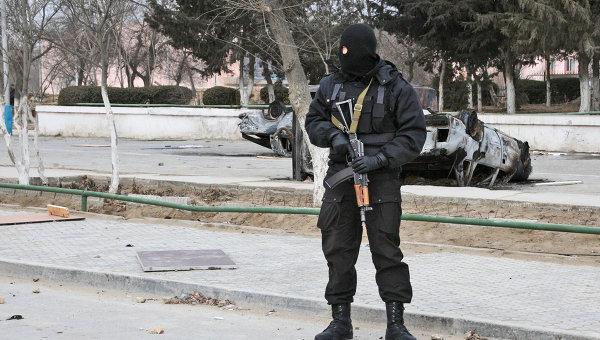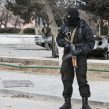
Kazakh Leader Extends State of Emergency in Zhanaozen
Publication: Eurasia Daily Monitor Volume: 9 Issue: 3
By:

Calm has been restored in the oil-rich western part of Kazakhstan after clashes between police and protesters on December 16-17 that left at least 16 people dead and more than 100 injured, including striking oil workers. But Kazakhstan’s cultivated image as a bastion of stability in volatile Central Asia and a haven for foreign investors has suffered as a result of both the Zhanaozen events and earlier insurgent attacks.
Two videos have been circulating on YouTube, one showing unarmed people apparently being shot at and beaten by police on December 16 in the oil town of Zhanaozen in the Mangistau region, and the other depicting a young man with a bloodstained shirt evidently shot dead lying on the ground and another wounded in the foot during the unrest. These videos, contradicting the initial official version that police only fired their weapons into the air and the ground, have shocked many.
A 20-day state of emergency and curfew imposed on Zhanaozen on December 17 has been extended by presidential decree until January 31. This is probably intended to prevent any possible disturbances in the days around the upcoming parliamentary elections on January 15.
A commission formed by members of civil society to investigate the events has called for the removal of the state of emergency. “The authorities tell us the situation has normalized. What is the point of maintaining the emergency situation?” asked commission member Mukhtar Taizhan. “Until it is removed, no help can be provided – neither legal, nor medical, nor humanitarian” (Kplus TV, December 29, 2011).
The Kazakh government is considering bringing in United Nations experts and independent experts from other countries “to ensure an objective and thorough investigation into the facts relating to the mass disturbances in Zhanaozen,” said Altai Abidullayev, spokesperson for the ministry of foreign affairs (www.mfa.kz, December 30, 2011).
Yet, in spite of the government’s declared openness and transparency, eye witnesses have reported numerous random arrests and beatings of detainees by police in Zhanaozen. In response, the government has set up a separate commission – aside from a government commission already established to look into the events – “to resolve complaints relating to the unlawful detention of citizens and use of illegal methods of investigation,” according to the ministry of foreign affairs (www.mfa.kz, December 30, 2011).
Violence erupted on December 16, the day Kazakhstan celebrated its 20th anniversary of independence, after seven months of strikes by oil workers demanding better pay and work conditions. Over 40 buildings were torched, including the headquarters of the Ozenmunaigaz energy company at the center of the dispute, the mayor’s office, two banks, shops, and a hotel, as well as cars and a bus. Internet and telephone connections with Zhanaozen were subsequently disconnected, but were later restored.
What triggered the unrest and how it unfolded continues to be unclear. People had gathered in the town’s main square in preparation for the Independence Day celebration. In the same square, oil workers had been protesting since May. A few observers have said that some of the striking oil workers may have worried about being sidelined by the celebrations, leading to the violence.
In any case, unidentified men wearing oil company jackets stormed the stage, broke sound equipment, and – as could be seen on footage shown on YouTube – chased away an outnumbered police force. Later, the rioters were said to have gone on a rampage through the town. At some point, “police were forced to use service weapons,” according to the prosecutor-general’s office. Protests then also took place at two other sites in western Kazakhstan, the town of Shepte and the regional capital Aktau.
President Nursultan Nazarbayev initially blamed “bandit elements” for the clashes and said they were taking advantage of the ongoing oil workers’ labor dispute. Since then, the prosecutor-general’s office has initiated a criminal case “on the fact of death caused by the use of weapons by police officers.”
Nazarbayev visited Zhanaozen only on December 22, but then took quick action. He replaced the regional governor with a former minister of interior. He also fired the heads of the national oil giant, KazMunaiGaz (KMG), and its London-listed production unit. On December 26, he sacked his billionaire son-in-law Timur Kulibayev, tipped as Nazarbayev’s possible successor and perhaps next prime minister after the parliamentary election, from his post as the head of the sovereign wealth fund Samruk-Kazyna. The fund owns KMG and has stakes in the companies whose workers were striking. Nazarbayev also promised employment either in town in newly created enterprises or in other parts of the country, for which training, accommodation and relocation will be provided.
These decisions have shown Nazarbayev to be firmly in the saddle, again, after months of doubts following a story in a German tabloid last July that he was suffering from prostate cancer and seeking treatment at a hospital in the northern German city of Hamburg. His seeming disregard for the situation in Zhanaozen over months up to the unrest and failure to get involved in what became the country’s longest labor dispute was widely seen as a sign of his growing weakness. The 71-year-old leader was declared to be “healthy” and “in excellent physical form” on December 27 after a medical checkup in the capital Astana, according to the president’s website (www.akorda.kz, December 27). This was an unusual and rare official statement, notable also for being publicized just one day after Kulibayev’s dismissal.
Zhanaozen is a one-industry town that has almost doubled its population over the past decade to about 90,000, in part due to the influx of ethnic Kazakh repatriates returning to their homeland from the Karakalpakistan region in Uzbekistan. Some even speak of a population of 120,000. According to government officials, such large-scale internal migration to a small place with limited employment opportunities should not have been permitted in the first place.
Salaries at the aging Uzen (or Ozen in Kazakh) oil field are already quite high after previous increases and cannot be raised higher than pay at newer and more prospective Kazakhstani oil fields, said minister of oil and gas Sauat Mynbayev at a press conference in Almaty back in October.




